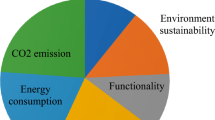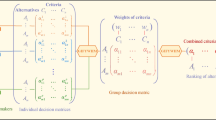Abstract
Q-rung orthopair fuzzy (q-ROF) set is one of the powerful tools for handling the uncertain multi-criteria decision-making (MCDM) problems, various MCDM methods under q-ROF environment have been developed in recent years. However, most existing studies merely concerned about the relationship between the criteria but they have not investigated the interactions between membership function and non-membership function. To explore the multiple heterogeneous relationships among membership functions and criteria, we propose a novel decision algorithm based on q-ROF set to deal with these using interactive operators and Maclaurin symmetric mean (MSM) operators. Specifically, the new interaction laws in the membership pairs of q-ROF sets are explained, and their properties are analyzed as the initial stage. Then, taking into account the influence of two or more factors on decision analysis, a q-ROF interaction Maclaurin symmetry mean (q-ROFIMSM) operator is formed based on the proposed interaction law to identify these factors’ interrelationship. Thirdly, based on the proposed operator with q-ROF information, a MCDM algorithm is developed and illustrated by numerical examples. An analysis of the feasibility, sensitivity, and superiority of the proposed framework is provided to validate our proposed method.





Similar content being viewed by others
References
Zadeh LA (1965) Fuzzy sets. Inf Control 8:338–353
Atanassov KT (1986) Intuitionistic fuzzy sets. Fuzzy Sets Syst 20:87–96
Atanassov K, Gargov G (1989) Interval valued intuitionistic fuzzy sets. Fuzzy Sets Syst 31:343–349
Grzegorzewski P (2004) Distances between intuitionistic fuzzy sets and/or interval-valued fuzzy sets based on the Hausdorff metric. Fuzzy Sets Syst 148:319–328
Xu ZS (2007) Intuitionistic fuzzy aggregation operators. IEEE Trans Fuzzy Syst 15:1179–1187
Xu ZS, Chen JA, Wu JJ (2008) Clustering algorithm for intuitionistic fuzzy sets. Inf Sci 178:3775–3790
Huang B, Wu WZ, Yan JJ, Li HX, Zhou XZ (2020) Inclusion measure-based multi-granulation decision-theoretic rough sets in multi-scale intuitionistic fuzzy information tables. Inf Sci 507:421–448
Liu BS, Zhou Q, Ding RX, Ni W, Herrera F (2019) Defective alternatives detection-based multi-attribute intuitionistic fuzzy large-scale decision making model. Knowl Based Syst 186:104962
Liu PS, Diao HY, Zou L, Deng AS (2020) Uncertain multi-attribute group decision making based on linguistic-valued intuitionistic fuzzy preference relations. Inf Sci 508:293–308
Rezvani S, Wang XZ, Pourpanah F (2019) Intuitionistic fuzzy twin support vector machines. IEEE Trans Fuzzy Syst 27:2140–2151
Tang J, Meng FY, Cabrerizo FJ, Herrera-Viedma E (2019) A procedure for group decision making with interval-valued intuitionistic linguistic fuzzy preference relations. Fuzzy Optim Decis Mak 18:493–527
Zeng SZ, Chen SM, Fan KY (2020) Interval-valued intuitionistic fuzzy multiple attribute decision making based on nonlinear programming methodology and TOPSIS method. Inf Sci 506:424–442
Yager RR (2016) Generalized orthopair fuzzy sets. IEEE Trans Fuzzy Syst 25(5):1222–1230
Gao J, Liang ZL, Shang J, Xu ZS (2019) Continuities, derivatives, and differentials of q-rung orthopair Fuzzy Functions. IEEE Trans Fuzzy Syst 27(8):1687–1699
Verma R (2020) Multiple attribute group decision-making based on order-alpha divergence and entropy measures under q-rung orthopair fuzzy environment. Int J Intell Syst 35(4):718–750
Du WS (2019) Research on arithmetic operations over generalized orthopair fuzzy sets. Int J Intell Syst 34(5):709–732
Liu DH, Chen XH, Peng D (2019) Some cosine similarity measures and distance measures between q-rung orthopair fuzzy sets. Int J Intell Syst 34(7):1572–1587
Peng XD, Liu L (2019) Information measures for q-rung orthopair fuzzy sets. Int J Intell Syst 34(8):1795–1834
Garg H, Chen SM (2020) Multiattribute group decision making based on neutrality aggregation operators of q-rung orthopair fuzzy sets. Inf Sci 517:427–447. https://doi.org/10.1016/j.ins.2019.11.035
Ju YB, Luo C, Ma J, Gao HX, Gonzalez E, Wang AH (2019) Some interval-valued q-rung orthopair weighted averaging operators and their applications to multiple-attribute decision making. Int J Intell Syst 34(10):2584–2606
Liu PD, Wang P (2018) Some q-rung orthopair fuzzy aggregation operators and their applications to multiple-attribute decision making. Int J Intell Syst 33(2):259–280
Ju YB, Luo C, Ma J, Wang AH (2019) A novel multiple-attribute group decision-making method based on q-rung orthopair fuzzy generalized power weighted aggregation operators. Int J Intell Syst 34(9):2077–2103
Chen K, Luo YD (2019) Generalized orthopair linguistic Muirhead mean operators and their application in multi-criteria decision making. Int J Intell Syst 37(1):797–809
Wei GW, Wei C, Wang J, Gao H, Wei Y (2019) Some q-rung orthopair fuzzy Maclaurin symmetric mean operators and their applications to potential evaluation of emerging technology commercialization. Int J Intell Syst 34:50–81
Wei GW, Gao H, Wei Y (2018) Some q-rung orthopair fuzzy Heronian mean operators in multiple attribute decision making. Int J Intell Syst 33:1426–1458
Liu PD, Liu JL (2018) Some q-Rung Orthopai fuzzy Bonferroni mean operators and their application to multi-attribute group decision making. Int J Intell Syst 33(2):315–347
Liu PD, Wang P (2019) Multiple-attribute decision-making based on Archimedean Bonferroni operators of q-rung orthopair fuzzy numbers. IEEE Trans Fuzzy Syst 27(5):834–848
Xing YP, Zhang RT, Zhou Z, Wang J (2019) Some q-rung orthopair fuzzy point weighted aggregation operators for multi-attribute decision making. Soft Comput 23:11627–11649
Yang W, Pang YF (2019) New q-rung orthopair fuzzy partitioned Bonferroni mean operators and their application in multiple attribute decision making. Int J Intell Syst 34(3):439–476
Xing YP, Zhang RT, Zhu XM, Bai KY (2019) q-Rung orthopair fuzzy uncertain linguistic choquet integral operators and their application to multi-attribute decision making. Int J Intell Syst 37(1):1123–1139
Atanassov K (1994) New operations defined over the intuitionistic fuzzy sets. Fuzzy Sets Syst 61:137–142
He YD, Chen HY, Zhou LG, Liu JP, Tao ZF (2014) Intuitionistic fuzzy geometric interaction averaging operators and their application to multi-criteria decision making. Inf Sci 259:142–159
Wei GW (2017) Pythagorean fuzzy interaction aggregation operators and their application to multiple attribute decision making. J Intell Fuzzy Syst 33:2119–2132
He YD, He Z (2016) Extensions of Atanassov’s intuitionistic fuzzy interaction Bonferroni means and their application to multiple-attribute decision making. IEEE Trans Fuzzy Syst 24:558–573
Liu PD, Chen SM, Liu JL (2017) Multiple attribute group decision making based on intuitionistic fuzzy interaction partitioned Bonferroni mean operators. Inf Sci 411:98–121
Garg H (2016) Generalized intuitionistic fuzzy interactive geometric interaction operators using Einstein t-norm and t-conorm and their application to decision making. Comput Ind Eng 101:53–69
Gao H, Lu M, Wei GW, Wei Y (2018) Some novel Pythagorean fuzzy interaction aggregation operators in multiple attribute decision making. Fundam Inform 159:385–428
Garg H, Arora R (2018) Novel scaled prioritized intuitionistic fuzzy soft interaction averaging aggregation operators and their application to multi criteria decision making. Eng Appl Artif Intell 71:100–112
Wang L, Li N (2020) Pythagorean fuzzy interaction power Bonferroni mean aggregation operators in multiple attribute decision making. Int J Intell Syst 35:150–183
Zhang L, He YD (2019) Extensions of intuitionistic fuzzy geometric interaction operators and their application to cognitive microcredit origination. Cogn Comput 11:748–760
Yager RR (2014) Pythagorean membership grades in multicriteria decision making. IEEE Trans Fuzzy Syst 22:958–965
Yang Z, Ouyang T, Fu X, Peng X (2020) A decision-making algorithm for online shopping using deep-learning-based opinion pairs mining and q-rung orthopair fuzzy interaction Heronian mean operators. Int J Intell Syst 735(5):83–825
Maclaurin C (1729) A second letter from Mr. Colin Mc Laurin, Professor of Mathematicks in the University of Edinburgh and F. R. S. to Martin Folkes, Esq; concerning the roots of equations, with the demonstration of other rules in algebra. Philos Trans 36:59–96
Acknowledgements
This work was supported in part by the Natural Science Foundation of China (No. 71704007), the Beijing Social Science Foundation of China (No. 18GLC082), and University Nursing Program for Young Scholars with Creative Talents in Heilongjiang Province (No. 2017103).
Author information
Authors and Affiliations
Corresponding authors
Ethics declarations
Conflict of interest
The authors declare that they have no conflict of interest.
Additional information
Publisher's Note
Springer Nature remains neutral with regard to jurisdictional claims in published maps and institutional affiliations.
Rights and permissions
About this article
Cite this article
Yang, Z., Garg, H., Li, J. et al. Investigation of multiple heterogeneous relationships using a q-rung orthopair fuzzy multi-criteria decision algorithm. Neural Comput & Applic 33, 10771–10786 (2021). https://doi.org/10.1007/s00521-020-05003-5
Received:
Accepted:
Published:
Issue Date:
DOI: https://doi.org/10.1007/s00521-020-05003-5




